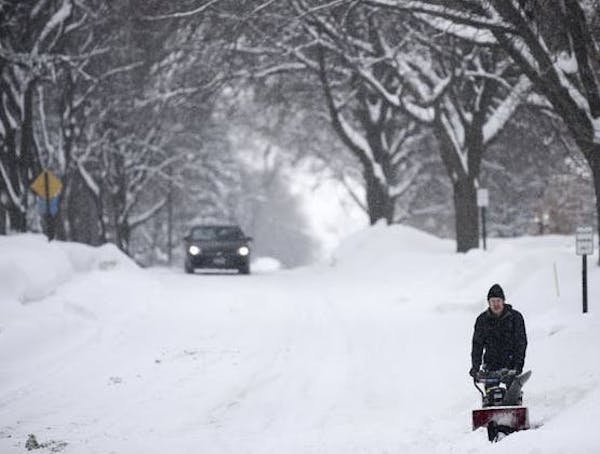The extreme cold came and we bundled up. Then the snow came and we shoveled, and then shoveled some more.
Now there's growing concern that winter's onslaught could bring trouble this spring. With snowbanks large enough to engulf small vehicles and another few inches of snow expected Friday, there's a higher-than-usual chance of spring flooding, said Craig Schmidt, senior service hydrologist with the National Weather Service in Chanhassen.
So far, steady cold has kept most of Minnesota's snow from melting, and 18 to 30 inches blanket the ground, Schmidt said. Underneath, the soil's frost depth is 2 to 4 feet. If the piles of snow melt too rapidly, much of the water would wash over the frozen ground into rivers, creeks and low-lying areas. Added to that, a fairly wet fall in some areas, particularly southern Minnesota, saturated the soil before the ground froze, leaving even fewer places for snowmelt to go, Schmidt said.
For now, however, it's a wait-and-see game from the Red River Valley down to the Mississippi, Minnesota and St. Croix rivers.
"There are two scenarios," Schmidt said. "In the best case, we would have a slow, gradual warmup with temperatures in the upper 30s and 40s during the day and then dropping to below freezing at night. If we get that, it's an orderly melt."
Streams and rivers would rise, creating some minor flooding but nothing catastrophic, he said. That scenario would mimic 2014, when the snowpack was as deep as this year's and the melt was gradual.
Then there's the worst case: a sudden warmup with a string of days featuring highs in the 60s and temperatures falling only to 40 to 45 degrees at night, with high dew points, setting off a rapid meltdown.
For those who watch flooding, the season took a turn in late January when cold and snow combined to rack up snow totals. In the Twin Cities, the 39 inches that fell last month made it the snowiest February on record.
In the Red River Valley, Grand Forks saw a record February, too, with 27 inches of snow, while Fargo broke its February record with 21.4 inches — at least three times more than the 6 to 7 inches that's normal in the month, said Amanda Lee, service hydrologist for the National Weather Service in Grand Forks.
"We just keep getting hit," she said. "It's been a long month."
Now there's a 50-50 chance the Red will reach a moderate flood stage in Grand Forks and possibly approach a major flood stage in Fargo, she said. Forecasters will provide another outlook next Thursday.
"We have to see what happens with the rest of winter and as we head into spring," Lee said. "As it gets closer to melt time, people will start putting more plans into action."
No big worries — yet
Over the past few years, river towns have reduced the danger of flooding by building levees, moving homes and businesses and making other improvements to keep water from inundating structures.
Montevideo has been building a levee system over the past 20 years along the Minnesota and Chippewa rivers, said city Public Works Director Aaron Blom. "It's not completed yet, but we're getting closer," he said.
"As far as the flooding issue, I'm not too concerned right now," Blom said. "That could change in two weeks if we get dumped on with 20 inches of wet, heavy snow or spring rains start coming and we haven't lost this snow yet. Then a guy is going to get a little bit concerned. We're monitoring it."
So are the folks in Fargo, where the river rose more than 40 feet over its banks in 2009 and swamped the city. Since then, Fargo has spent $438 million to build dikes, raise roads and buy 400 homes, according to Mayor Tim Mahoney. But the city continues to grow, and another $140 million in mitigation work is still needed, he said.
In the meantime, Mahoney is keeping an eye on the rising snow. "We're supposed to get another 2 to 6 inches this weekend," he said. "It's March now, and we haven't had much melt. Usually we get some melt by now."
At this point, there's a 50-50 probability that the Red River will reach 30 feet over its banks, he said. Nuisance flooding occurs at 18 feet. Flooding up to 30 feet is easily defended against, he said.
But a flood higher than 30 feet will prompt crews to build clay dikes and pile up sandbags.
Where it ends up will depend on what March brings, Mahoney said.
Like others who are winter-weary, he's ready for a nice, slow thaw — any time now.
Brooklyn Park City Council member censured for 2nd time

This St. Paul native now goes by Kandi Krush, and she body-slams her opponents in the ring
Man agrees to 6-year sentence for fatally shooting Hopkins man on edge of downtown Minneapolis

